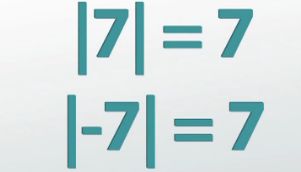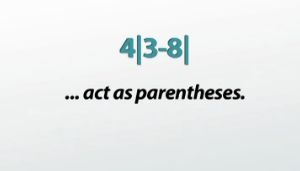What is an Absolute Value? - Answers
The answers are in BOLD below.
NOTE: The transcript from the video is listed below the quiz for your reference.
1. Why did the story about my Super Bowl bet relate to absolute values?
- We were guessing really big numbers
- If one person guessed over the actual answer they automatically lost
- We both guessed negative numbers
- The winner was the person who guessed the number that was the closest to the correct answer
- We both guessed positive numbers
2. Fill in the blanks with the correct to words. Absolute values make positive numbers ________ and make negative numbers ______________.
- zero, zero
- negative, negative
- negative positive
- positive, negative
- positive, positive
3. We write absolute values with which symbol?
- !
- [ ]
- | |
- ( )
- { }
4. Evaluate |4+7|-|4-7|
- -22
- 14
- 8
- 22
- 0
5. Evaluate |5-3|+4|3-5|
- -6
- 8
- 40
- -6
- 10
When we're talking and comparing numbers, we often don't care whether its positive or negative, just how big it is. This is often called the magnitude of a number and we find it by taking the absolute value. Learn all about it here!
The Distance from Zero
One February, during Super Bowl XLV, which was the Packers vs. the Steelers, I made a bet with a friend over how much money it costs to get a 30-second commercial on during one of the commercial breaks. Now I'm a huge Packers fan and he was a Steelers fan, so we decided that the loser would have to wear the opposing team's jersey for the rest of the game.
I thought it would cost around $1,250,000 and my friend was convinced that it cost $5,500,000. I wasn't sure if I was exactly right or not, but I was pretty confident that he was way off, so I decided to make the bet.
 |
Well, a few internet searches later, we discovered that a 30-second commercial that year cost $3,000,000. So who won? Well, a simple calculation of $3,000,000 minus $1,250,000 gave us the answer that I was $1,750,000 off the actual answer. Doing the same for him, $3,000,000 minus $5,500,000 told us that he was $2,500,000 off. This means that I was definitely closer, so I won and my Packer pride stayed intact.
But a closer inspection into this reveals a situation that actually comes up a lot in mathematics. What my friend and I cared about was purely how far away our guess was from the actual answer. We didn't care about whether we were over or under, or whether the number we did after the little subtraction problem was positive or negative. All that we cared about was the magnitude of the answer, or how large the number was regardless of the sign in front of it. In mathematics, this operation of taking the number and only looking at the size of it and ignoring the sign, is called the absolute value.
We often use absolute values when talking about distance because there is no such thing as negative distance. For example, just because the store you're going to is a block behind you doesn't mean it's negative one blocks away. It's just one block, right?
Notation of Absolute Values
Just like how the winner of our bet was the one whose guess was less far away from the answer, the absolute value of any number can be thought of as how far away that number is from zero. For example, the absolute value 7 (written as |7|)? Still 7. It's 7 units away from zero. The absolute value of -7 (written as |-7|)? 7, because it's still 7 units away from zero.
 |
Notice that we use these straight up and down bars around the number to indicate that we're taking the absolute values. And, also, the important thing to note here is that the absolute value turns negative numbers positive but leave positive numbers exactly the same.
Solving Equations with Absolute Values
There are a few things to be wary of when evaluating absolute values. Let's take the expression we've got right here: 4|3-8|. First, we need to know that the absolute value bars act as parentheses. That means that order of operations say that we have to first do whatever is on the inside and then worry about the stuff hanging out on the outside. Also, because they're kind of like parentheses, when you have a number in front of them, it implies multiplication.
 |
The second thing you need to be careful of is that just because absolute values make things positive does not mean that we are going to change the subtraction sign that's going on on the inside into an addition sign. The absolute value operation only happens once everything else on the inside has been done.
This means that in this problem, we would first simply do 3 - 8 and get -5. Now that we're finished with everything on the inside, now we can take the absolute value of -5, which turns it into 5. Because the number 4 was simply sitting in front of the absolute value, it implies multiplication, and 4 times 5 is 20.
Lesson Summary
To review, absolute values are used when we don't care about the sign of the number, simply its magnitude or how large of a number it is, regardless of whether it's positive or negative. You can think of the absolute value of any number as its distance away from zero. Absolute values are denoted with two straight up and down parallel bars (e.g., |8|) and make negative numbers positive, while leaving positive numbers alone.